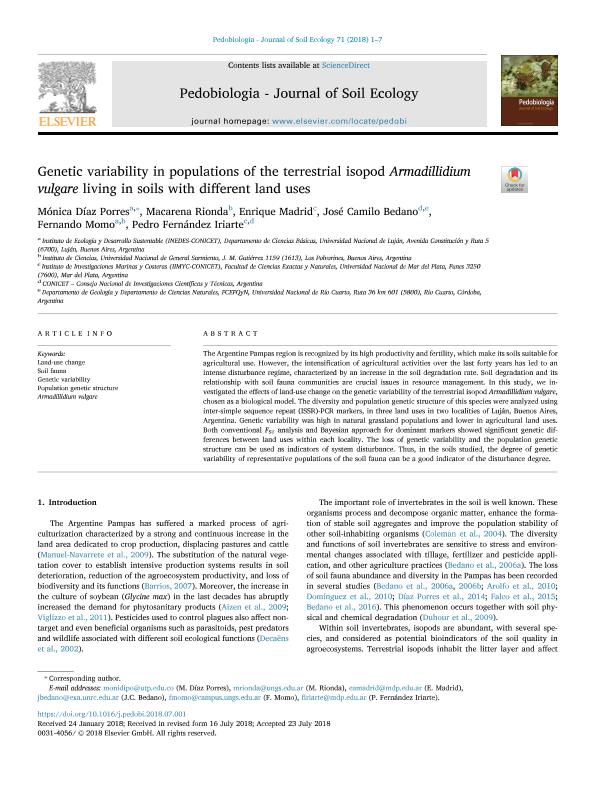Artículo
Genetic variability in populations of the terrestrial isopod Armadillidium vulgare living in soils with different land uses
Diaz Porres, Monica ; Rionda, Macarena; Madrid, Enrique; Bedano, José Camilo
; Rionda, Macarena; Madrid, Enrique; Bedano, José Camilo ; Momo, Fernando Roberto; Fernandez Iriarte, Pedro Jose
; Momo, Fernando Roberto; Fernandez Iriarte, Pedro Jose
 ; Rionda, Macarena; Madrid, Enrique; Bedano, José Camilo
; Rionda, Macarena; Madrid, Enrique; Bedano, José Camilo ; Momo, Fernando Roberto; Fernandez Iriarte, Pedro Jose
; Momo, Fernando Roberto; Fernandez Iriarte, Pedro Jose
Fecha de publicación:
11/2018
Editorial:
Elsevier Gmbh
Revista:
Pedobiologia
ISSN:
0031-4056
e-ISSN:
1873-1511
Idioma:
Inglés
Tipo de recurso:
Artículo publicado
Clasificación temática:
Resumen
The Argentine Pampas region is recognized by its high productivity and fertility, which make its soils suitable for agricultural use. However, the intensification of agricultural activities over the last forty years has led to an intense disturbance regime, characterized by an increase in the soil degradation rate. Soil degradation and its relationship with soil fauna communities are crucial issues in resource management. In this study, we investigated the effects of land-use change on the genetic variability of the terrestrial isopod Armadillidium vulgare, chosen as a biological model. The diversity and population genetic structure of this species were analyzed using inter-simple sequence repeat (ISSR)-PCR markers, in three land uses in two localities of Luján, Buenos Aires, Argentina. Genetic variability was high in natural grassland populations and lower in agricultural land uses. Both conventional FST analysis and Bayesian approach for dominant markers showed significant genetic differences between land uses within each locality. The loss of genetic variability and the population genetic structure can be used as indicators of system disturbance. Thus, in the soils studied, the degree of genetic variability of representative populations of the soil fauna can be a good indicator of the disturbance degree.
Archivos asociados
Licencia
Identificadores
Colecciones
Articulos(IIMYC)
Articulos de INSTITUTO DE INVESTIGACIONES MARINAS Y COSTERAS
Articulos de INSTITUTO DE INVESTIGACIONES MARINAS Y COSTERAS
Citación
Diaz Porres, Monica; Rionda, Macarena; Madrid, Enrique; Bedano, José Camilo; Momo, Fernando Roberto; et al.; Genetic variability in populations of the terrestrial isopod Armadillidium vulgare living in soils with different land uses; Elsevier Gmbh; Pedobiologia; 71; 11-2018; 1-7
Compartir



